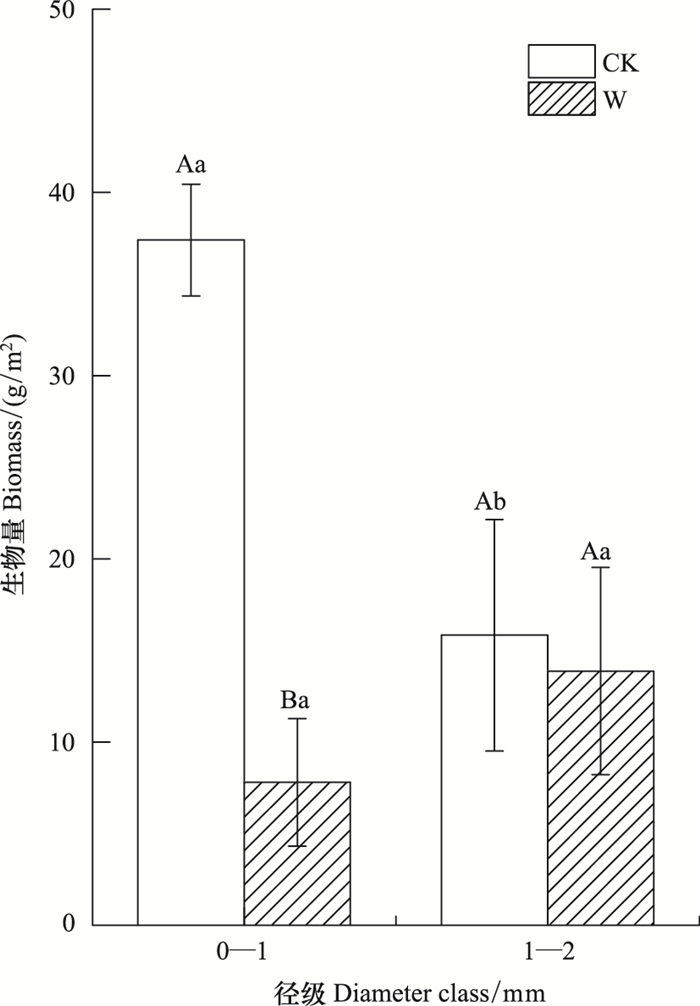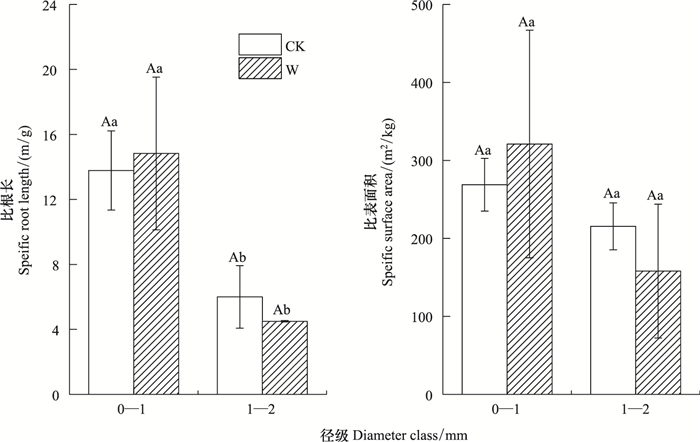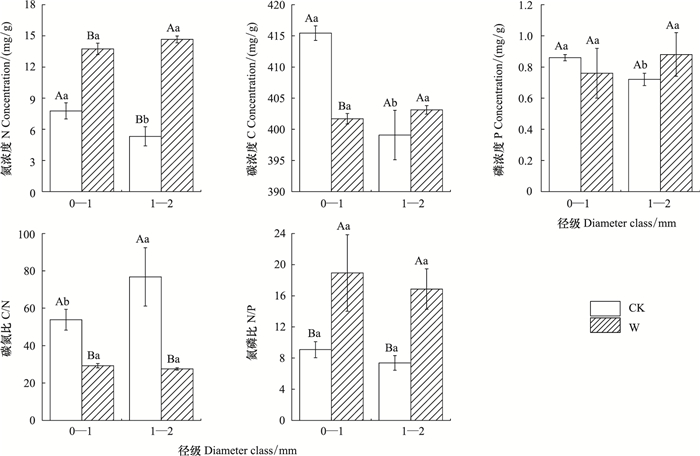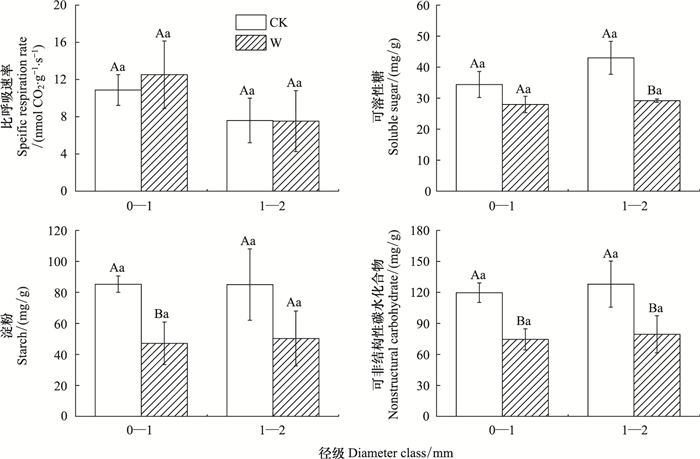文章信息
- 冯建新, 熊德成, 史顺增, 许辰森, 钟波元, 邓飞, 陈云玉, 陈光水, 杨玉盛
- FENG Jianxin, XIONG Decheng, SHI Shunzeng, XU Chensen, ZHONG Boyuan, DENG Fei, CHEN Yunyu, CHEN Gunagshui, YANG Yusheng.
- 土壤增温对杉木幼苗细根生理生态性质的影响
- Effects of soil warming on the ecophysiological properties of the fine roots of Chinese fir (Cunninghamia lanceolata) seedlings
- 生态学报[J]. 2017, 37(1): 35-43
- Acta Ecologica Sinica[J]. 2017, 37(1): 35-43
- http://dx.doi.org/10.5846/stxb201603260543
-
文章历史
- 收稿日期: 2016-03-26
- 修订日期: 2016-07-11
2. 福建师范大学湿润亚热带山地生态国家重点实验室培育基地, 福州 350007
2. State Key Laboratory of Subtropical Mountain Ecology (Founded by Ministry of Science and Technology and Fujian Province), Fujian Normal University, Fuzhou 350007, China
IPCC (2013)第五次报告指出, 由于大气温室气体上升引起的气候变化导致最近130年(1880-2012)全球海陆表面平均温度升高了0.85 ℃, 预计2016-2035年全球地表平均温度将上升0.3-0.7 ℃; 到21世纪末将升高0.3-4.8 ℃[1]。温度升高可能直接或间接影响森林生态系统的地上和地下生态过程[2]。虽然森林细根占根系总生物量的比例不足30%[3], 但在森林生态系统养分循环和能量流动中起到重要作用。而且, 细根本身是植物养分、水分的吸收器官, 因而细根生理生态性质的变化与林木生长和森林生产力紧密相关。相关的研究表明, 细根生长与土壤或者空气温度相关[4]。但至目前为止, 关于温度升高对地下部分尤其是对细根的生理生态性质的研究还很缺乏。
植物细根对增温的生理生态响应可能体现在诸多方面, 如细根生物量分配、细根形态(比根长, SRL; 比表面积, SRA)、细根元素化学计量学(C、N、P)、细根代谢(呼吸; 非结构性碳水化合物, NSC)等, 这些变化均体现了植物对全球变暖的适应性。增温可能会对细根生物量产生增加、减少或者无影响。例如在加拿大汤普森南部的黑云杉(Picea mariana)森林发现活细根( < 2 mm)生物量在增温样地下降了24%-46%[5]。与对照地区相比, 黄石国家公园增温地区生长的翦股颖(Agrostis scabra)和匍茎剪股颖(Agrostis stolonifera)细根生物量分别降低了8%、15%[6]。研究发现美国佛罗里达州盖恩斯维尔地区橙树幼苗细根生物量( < 4 mm)和总细根生物量随着温度升高而略有增加[7]。细根SRL, SRA是根系生长发育和反应根功能情况的重要特征之一, 但只有极少数的研究考虑到温度对细根形态的影响[8]。增温对细根元素化学计量学的影响主要集中在对细根C、N的影响上, 而对细根P含量的影响较小。例如在美国马萨诸塞州的落叶林中, 土壤增温虽然没有显著的改变细根C含量, 但在增温地区活细根N含量比对照地区高出10.5%[9]。目前细根呼吸对温度的敏感性受到较大关注, 如已有的研究证明根呼吸随着温度呈指数递增[10-11]并且Q10值往往在1.8-3.0之间[12-13]。但根呼吸是否对温度产生驯化仍是一个争议的问题, 且增温后根系呼吸的变化如何影响根系代谢平衡(如NSC的消耗)目前亦不清楚。
我国人工林面积占世界1/3, 湿润亚热带是我国最重要的人工林基地。其中杉木林是最重要的人工林之一, 占世界人工林面积的6%, 在我国林业生产和森林碳汇中发挥着重要作用[14]。之前的增温研究主要集中在高纬度温带地区[15-17], 但是更多的证据显示热带亚热带森林对全球变暖的响应更加敏感[18]。基于以上方面, 本研究以杉木为研究对象, 采用野外土壤增温方式, 探讨增温对杉木幼苗细根生理生态特性(包括细根生物量、形态(SRL、SRA)、化学计量学(C、N、P)、呼吸和NSC)的影响。这对预测全球变暖背景下我国湿润亚热带人工林生产力变化和人工林的适应性管理具有重要作用。
1 试验地概况和研究方法 1.1 试验地概况试验地位于福建三明森林生态系统与全球变化研究站陈大观测点, 金丝湾森林公园陈大林业国有林场内(26°19′N, 117°36′E)。平均海拔300 m, 属中亚热带季风气候, 年均气温19.1 ℃, 年平均降雨量1749 mm (主要集中在3-8月份), 年均蒸发量1585 mm, 相对湿度81%。
1.2 试验设计试验采用完全随机设计, 设置增温(+5 ℃)、不增温(对照)两种处理, 小区面积2 m×2 m, 每个处理5个重复。试验小区四周采用4块PVC板(200 cm×70 cm深)焊接而成, 与周围土壤隔开, 防止小区之间相互干扰。小区土壤取自附近的杉木林土壤, 分层(0-10、10-20、20-70 cm)取回, 剔除粗根、石块和其他杂物后, 土壤分层混合均匀, 并按20-70、10-20和0-10 cm重填回2 m×2 m实验小区内, 同时采用压实法调整土壤容重与原位土壤容重接近。于2013年10月安装加热电缆(增温和不增温小区都布设相同电缆), 平行布设, 深度为10 cm, 间距20 cm, 并在最外围环绕一圈, 保证样地增温的均匀性。2013年11月, 每个2 m×2 m小区均匀种植4棵1年生2代半短侧枝杉木幼苗, 杉木位置均处于两条电缆线之间。电缆布设完成后5个月(2014年3月)开始通电增温。2015年1月末(增温后1年左右)对照(CK)和增温(W)样地土壤各理化性质(0-20 cm)见表 1。
| 土壤性质Soil property | 处理Treatment | |
| 对照Control | 增温Warming | |
| 温度Temperature/℃ | 11.75±1.05 | 17.05±1.17 |
| 含水率Moisture content | 19.4±2.25 | 13.72±2.02 |
| 可溶性有机碳Dissolved organic carbon/(mg/kg) | 6.01±1.32 | 7.07±1.54 |
| 可溶性有机氮Dissolved organic nitrogen/(mg/kg) | 4.16±0.77 | 25.98±9.61 |
| 全磷Total phosphorus/(mg/kg) | 214.31±14.38 | 209.55±12.75 |
2015年1月末(增温后1年左右), 采用土芯法在CK和W小区内对根系进行随机取样, 每个小区取4个土钻, 土钻直径3.5 cm, 取样深度分0-10、10-20、20-40和40-60 cm。按照土层深度将杉木根挑出后立即带回实验室清洗, 剔除死根后按照0-1 mm和1-2 mm分径级。分别装入信封袋中放进65 ℃烘箱中烘至恒重并称重。细根生物量是4个土层相加累计而得。
1.4 细根呼吸、形态、元素含量和NSC测定 1.4.1 根系取样与处理采用半径为10 cm、高度为20 cm的内生长环在CK和W每个小区中心位置进行取样, 每个小区取一个样, 并立即在野外把细根挑出, 然后带回实验室清洗干净。根据细根的颜色、外形等区分出活死根, 再按照0-1 mm和1-2 mm分出径级。取少量的各径级活根放入盛有生理缓冲液(10 mmol/L MES, 1 mmol/L CaSO4)的烧杯中, 然后进行恒温(18 ℃)水浴, 以备细根呼吸测定之用; 其他的活根用微波炉杀青3 min后装入信封袋并放入烘箱中烘干至恒重。杀青烘干后的细根样品用球磨仪进行粉碎后待用。
1.4.2 细根呼吸测定根系呼吸使用Oxytherm液相氧电极测定。将已经水浴过的活根放入氧电极的反应杯里, 并吸取2 ml缓冲液倒入, 当呼吸反应达到稳定状态后开始测定氧消耗量, 每个小区各径级的活根测定3次。本试验测定的细根呼吸从分根到测定完成在2 h内。
1.4.3 细根形态测定呼吸样品测定完后用数字化扫描仪Espon scanner对根进行扫描, 扫描完成后放入65 ℃烘箱中烘干并称重。而扫描后的根系图像运用Win-RHIZO (Pro 2009b)根系图像分析软件进行形态特征分析。
1.4.4 细根元素含量与非结构性碳测定细根的C、N使用VarioEL III元素分析仪进行测定。称取粉碎的样品8-10 mg进行包样, 把包好的样品放入进样盘进行测定。每个处理各径级测定3次。
细根P的测定方法:精确称取0.25 mg (±0.0001 g)细根样品, 加入4 mL硫酸和1 mL高氯酸摇匀, 静置1d后消煮3 h, 冷却后定容至100 mL。取上清液应用流动分析仪进行测定。
细根NSC的测定:包括可溶性糖和淀粉使用改进后的酚-硫酸法[19-20]。
1.5 数据分析采用双因素ANOVA检验处理、径级以及其交互作用对细根生物量、SRL、SRA、C、N、P、C/N、N/P、比呼吸速率(SRR)、可溶性糖、淀粉及NSC的影响。同一径级不同处理之间、同一处理不同径级之间细根生物量、SRL、SRA、C、N、P、C/N、N/P、SRR、可溶性糖、淀粉及NSC的差异采用独立样本t检验。所有的统计分析均在SPSS 19.0软件上进行, 显著性水平设定为P=0.05。
2 结果 2.1 细根生物量和形态处理、径级以及两者之间的交互作用对细根生物量(0-60 cm)的影响达到显著水平(P < 0.05), 其中处理对细根生物量的影响达到极显著水平(P < 0.01)(表 2)。土壤增温后0-1 mm的细根生物量显著降低(P < 0.05);1-2 mm的细根生物量差异不显著(P>0.05)(图 1)。同一处理, 与0-1 mm相比, CK的1-2 mm的细根生物量显著降低(P < 0.05), 而W的1-2 mm的细根生物量差异不显著(P>0.05)(图 1)。处理以及处理与径级之间的交互作用对细根SRL、SRA (0-20 cm)没有影响(P>0.05), 而径级对细根SRA的影响达到显著水平(P < 0.05), 对细根SRL没有影响(P>0.05)(表 2)。W与CK间各径级细根SRL、SRA的差异均不显著(P>0.05)。与0-1 mm相比, CK和W的1-2 mm的细根SRL显著降低(P < 0.05)(图 2A), 而细根SRA的差异不显著(P>0.05)(图 2B)。

|
| 图 1 不同处理各径级的细根生物量 Fig. 1 Fine root biomass of different diameter class under different treatments CK, 对照control; W, 增温warming.不同大写字母表示同一径级不同处理差异显著, 不同小写字母表示同一处理不同径级差异显著; 图中数据为平均值±标准差 |

|
| 图 2 不同处理各径级的细根比根长与比表面积 Fig. 2 Fine root specific root length and specific root surface area of different diameter class under different treatments 不同大写字母表示同一径级不同处理差异显著, 不同小写字母表示同一处理不同径级差异显著; 图中数据为平均值±标准差 |
| 指标Index | P | ||
| 处理Treatment | 径级Diameter class | 处理×径级Treatment×Diameter class | |
| 生物量Biomass/(g/m2) | 0.006 | 0.044 | 0.011 |
| 比根长Specific root length/(m/g) | 0.910 | 0.340 | 0.519 |
| 比表面积Specific root surface area/(m2/kg) | 0.768 | 0.034 | 0.232 |
| 氮N/(mg/g) | 0.000 | 0.034 | 0.006 |
| 碳C/(mg/g) | 0.010 | 0.006 | 0.002 |
| 磷P/(mg/g) | 0.584 | 0.880 | 0.138 |
| 碳氮比C/N | 0.001 | 0.055 | 0.042 |
| 氮磷比N/P | 0.004 | 0.289 | 0.923 |
| 比呼吸速率Specific respiration rate/(nmolCO2 g-1 s-1) | 0.998 | 0.002 | 0.280 |
| 可溶性糖Soluble sugar/(mg/g) | 0.005 | 0.130 | 0.321 |
| 淀粉Starch/(mg/g) | 0.017 | 0.503 | 0.330 |
| 非结构性碳水化合物Nonstructural carbohydrates/(mg/g) | 0.005 | 0.847 | 0.490 |
处理对细根N、C、C/N、N/P的影响达到极显著水平(P < 0.01), 对细根P没有影响(P>0.05);径级对细根C的影响达到极显著水平(P < 0.01), 对细根N的影响达到显著水平(P < 0.05), 对细根P、C/N、N/P没有影响(P>0.05);处理与径级的交互作用对细根N、C的影响达到极显著水平(P < 0.01), 对细根C/N的影响达到显著水平(P < 0.05), 对细根P、N/P没有影响(P>0.05)(表 2)。与CK相比, W处理各径级细根N、N/P均显著增加(P < 0.05)(图 3), 细根C/N显著降低(P < 0.05)(图 3), 而在0-1 mm细根C显著降低(P < 0.05)(图 3)、细根P差异不显著(P>0.05)(图 3), 在1-2 mm细根C、P差异不显著(P>0.05)(图 3)。与0-1 mm相比, CK的1-2 mm的细根N、C、P均显著降低(P < 0.05)(图 3), 细根C/N显著升高(P < 0.05)(图 3), 细根N/P差异不显著(P>0.05)(图 3); W的1-2 mm的细根N、C、P、C/N、N/P差异均不显著(P>0.05)(图 3)。

|
| 图 3 不同处理各径级的细根C浓度、N浓度、P浓度和C/N、N/P Fig. 3 Concentrations of C, N, P and ratios of C/N, N/P of different diameter class of fine roots under different treatments 不同大写字母表示同一径级不同处理差异显著, 不同小写字母表示同一处理不同径级差异显著; 图中数据为平均值±标准差 |
处理以及处理与径级间的交互作用对细根SRR没有影响(P>0.05), 径级对细根SRR的影响达到极显著水平(P < 0.01)(表 2)。与CK相比, 土壤增温后各径级细根SRR差异均不显著(P>0.05)(图 4)。与0-1 mm相比, CK和W的1-2 mm的细根SRR差异不显著(P>0.05)(图 4)。处理对可溶性糖和NSC的影响达到极显著水平(P < 0.01), 对淀粉的影响达到显著水平(P < 0.05), 径级以及处理与径级间的交互作用对可溶性糖、淀粉和NSC没有影响(P>0.05)(表 2)。与CK相比, 土壤增温后各径级细根淀粉和NSC均显著降低(P < 0.05)(图 4), 而细根可溶性糖在0-1 mm差异不显著(P>0.05), 在1-2 mm显著降低(P < 0.05)(图 4)。与0-1 mm相比, CK和W的1-2 mm的可溶性糖、淀粉和NSC差异均不显著(P>0.05)(图 4)。

|
| 图 4 不同处理各径级的细根比呼吸速率、可溶性糖、淀粉和非结构性碳水化合物 Fig. 4 Fine root specific respiration rate, soluble sugar, starch and nonstructural carbohydrate of different diameter class under different treatments 不同大写字母表示同一径级不同处理差异显著, 不同小写字母表示同一处理不同径级差异显著; 图中数据为平均值±标准差 |
本研究结果显示, 土壤增温后, 0-1 mm细根生物量(0-60 cm)显著降低, 这与许多研究报道相一致[21-24]。例如Wan等[25]发现与对照相比, 增温样地红枫(Acer rubrum)和糖枫(Acer saccharum)细根生物量显著降低。造成土壤增温细根生物量下降的原因一方面是土壤增温后, 土壤变得干旱, 影响了植物光合作用和生长, 导致地上和地下生物量的减少[26-27]。另一方面是增温促进土壤氮有效性增加[15, 28], 导致细根特别是0-1 mm细根分配(投入)的相对降低。本试验中, 土壤增温后, 0-1 mm细根生物量显著降低, 而1-2 mm细根生物量却没有变化。一种原因是0-1 mm细根是养分吸收的主要器官, 土壤增温后养分有效性增加引起吸收根的降低; 而1-2 mm细根主要是结构根, 养分有效性增加可能对结构根的影响较小。另一种原因可能是增温引起直径较小的细根分解死亡更快[29], 也相对更容易成为食物或者被分解[30]。
本研究结果还表明, 土壤增温对细根形态(SRL、SRA)(0-20 cm)没有影响。Alvarez-uria等[31]研究表明土壤增温对瑞士的绿赤杨(Alnus viridis)、普通赤杨(Alnus glutinosa)、挪威云杉(Picea abies)、樟子松(Pinus sylvestris)、瑞士石松(Pinus cembra)、垂枝桦(Betula pendula)6个物种细根SRL没有影响, Equiza等[32]研究指出土壤-空气增温对春季小麦细根SRA没有作用, 这与本研究结果相一致。造成这种结果的原因可能是根系对养分有效性的响应更多地通过细根生物量特别是0-1 mm细根的调整(即分配的调整), 而细根形态上的调整相对很小[33]。
3.2 土壤增温对细根化学计量学特征的影响本试验发现土壤增温显著的增加了细根N浓度, 显著的降低了C/N比率, 而对1-2 mm细根C浓度没有影响, 这个结果与Zhou等[9]研究结果一致。Zogg[34]、Bassirirad[35]和Wan[25]等人研究发现土壤增温增加了细根N浓度是因为在更高的温度下细根活性更强, 土壤N有效性增加, 导致活细根吸收N浓度增加。土壤增温后0-1 mm细根C浓度下降, 而1-2 mm细根C浓度却没发生变化, 可能是因为0-1 mm细根主要是吸收根, 土壤增温增加了土壤N有效性, 导致土壤C向0-1 mm细根分配的比例相对减少, 而1-2 mm细根主要是结构根, 土壤增温虽然增加了土壤N有效性, 但细根吸收N浓度只是积累于细根中而不参与代谢, 导致土壤C向1-2 mm细根分配的比例并未变化。土壤增温细根C/N比率显著降低是因为细根吸收N显著增加而吸收C显著降低或没有变化。本试验还发现土壤增温对细根P浓度没有影响, 这可能是因为土壤P是很容易被固定的元素, 特别是亚热带土壤P极易被固定, P有效性极低, 即使是土壤增温也未能明显促进土壤P的矿化速率, 导致根系对P的吸收并未明显变化。但土壤增温后细根N浓度的升高导致N/P比率显著升高表明了土壤增温可能导致营养元素失衡, 特别是受P营养的限制可能更为强烈[36]。
3.3 土壤增温对细根代谢特征的影响本试验发现在18 ℃参考温度下测得CK与W两个处理的SRR没有变化, 说明土壤增温后细根呼吸还没有出现驯化现象, 即在增温条件下W处理的细根呼吸应更高于CK。Burton等[37]研究表明, 在6 ℃和18 ℃参照温度下对密歇根州90a的糖槭(sugar maple)进行细根呼吸测定, 发现土壤温度的季节性变化没有对细根呼吸产生温度驯化, 这与本试验的结果类似。造成土壤增温后细根呼吸未出现驯化的原因可能有以下原因:1)试验样地增温才1a, 增温时间跨度还不大; 2)增温样地的温度未能达到细根呼吸驯化的阀值[37]。但也有一些研究发现细根呼吸会产生部分温度驯化, 驯化受到底物限制和腺苷酸控制的影响[38]。多数研究发现植物组织N浓度与呼吸速率往往存在强烈的正相关性[39-40], 而本试验发现在18 ℃参照温度下, W细根的N浓度显著高于CK, 但W和CK处理细根呼吸没有差异。这可能是因为土壤N浓度超出了杉木幼苗所需的N浓度, 超出的部分N浓度不参与N的吸收和同化而只是积累于细根中。
本试验结果显示土壤增温后, 细根NSC显著下降。Karst等[41]研究表明加拿大阿尔伯塔省罗奇波尔附近的处于生长期的黑云杉和黑松(Pinus contorta)幼苗随着土壤温度降低根系NSC浓度升高, 这与本试验结果类似。同时, 本试验发现对照试验中可溶性糖、淀粉分别占NSC的31.25%、68.75%, 增温试验中可溶性糖、淀粉分别占NSC的36.81%、63.19%, 说明增温促使贮存的淀粉更多的相对比例转化为可溶性糖, 这亦表明了增温后细根对NSC消耗增加, 更多地动用了NSC贮存。造成这种结果可能是因为以下几个原因:1)土壤增温, 土壤变得干旱, 降低了植物的光合速率, 致使淀粉和可溶性碳向细根的运输减少; 2) W处理的细根呼吸没有发生驯化, 所以导致NSC加速消耗。这表明增温后导致了细根出现一定的代谢失衡现象, 这有可能引起根系功能障碍, 并引起细根死亡增加, 寿命缩短(未刊资料), 从而对杉木的养分、水分吸收和杉木生长产生影响。
4 结论本试验可以发现:1)土壤增温后0-1 mm细根生物量显著下降, 1-2 mm细根生物量没有变化, 细根形态也没有发生变化, 说明了根系对养分有效性的响应更多地通过细根生物量特别是0-1 mm细根的调整, 而细根形态上的调整相对较少; 2)土壤增温后细根N浓度和N/P显著增加, 细根C/N显著降低, 0-1 mm细根C浓度显著降低, 而1-2 mm细根C浓度没有变化, 细根P浓度也没有变化, 表明土壤增温后细根营养元素失衡, 对N/P的分析说明了增温样地杉木幼苗更易受到P素的限制; 3)土壤增温后细根呼吸没有出现驯化现象, 细根NSC显著下降, 表明增温后细根出现一定的代谢失衡现象, 并引起细根死亡增加, 寿命缩短, 从而对杉木的养分、水分吸收和杉木生长产生影响。
| [1] | IPCC.Climate change 2013:The physical science basis. Contribution of Working Group I to the Fifth Assessment Report of the Intergovernment Panel on Climate Change. Cambridge: Cambridge University Press, 2013. |
| [2] | Way D A, Oren R. Differential responses to changes in growth temperature between trees from different functional groups and biomes:a review and synthesis of data. Tree physiology , 2010, 30 (6) : 669–688. DOI:10.1093/treephys/tpq015 |
| [3] | Vogt K A, Grier C C, Vogt D J. Production, turnover, and nutrient dynamics of above-and belowground detritus of world forests. Advances in ecological research , 1986, 15 : 303–377. DOI:10.1016/S0065-2504(08)60122-1 |
| [4] | Tierney G L, Fahey T J, Groffman P M, Hardy J P, Fitzhugh R D, Driscoll C T, Yavitt J B. Environmental control of fine root dynamics in a northern hardwood forest. Global Change Biology , 2003, 9 (5) : 670–679. DOI:10.1046/j.1365-2486.2003.00622.x |
| [5] | Bronson D R, Gower S T, Tanner M, Linder S, Van Herk I. Response of soil surface CO2 flux in a boreal forest to ecosystem warming. Global Change Biology , 2008, 14 (4) : 856–867. |
| [6] | Lyons E M, Pote J, DaCosta M, Huang B R. Whole-plant carbon relations and root respiration associated with root tolerance to high soil temperature for Agrostis grasses. Environmental and Experimental Botany , 2007, 59 (3) : 307–313. DOI:10.1016/j.envexpbot.2006.04.002 |
| [7] | Allen L H, Vu J C V. Carbon dioxide and high temperature effects on growth of young orange trees in a humid, subtropical environment. Agricultural and Forest Meteorology , 2009, 149 (5) : 820–830. DOI:10.1016/j.agrformet.2008.11.002 |
| [8] | Pregitzer K S, King J S, Burton A J, Brown S E. Responses of tree fine roots to temperature. New Phytologist , 2000, 147 (1) : 105–115. DOI:10.1046/j.1469-8137.2000.00689.x |
| [9] | Zhou Y M, Tang J W, Melillo J M, Butler S, Mohan J E. Root standing crop and chemistry after six years of soil warming in a temperate forest. Tree Physiology , 2011, 31 (7) : 707–717. DOI:10.1093/treephys/tpr066 |
| [10] | Atkin O K, Edwards E J, Loveys B R. Response of root respiration to changes in temperature and its relevance to global warming. New Phytologist , 2000, 147 (1) : 141–154. DOI:10.1046/j.1469-8137.2000.00683.x |
| [11] | Apostol K G, Jacobs D F, Wilson B C, Salifu K F, Dumroese R K. Growth, gas exchange, and root respiration of Quercus rubra seedlings exposed to low root zone temperatures in solution culture. Forest ecology and management , 2007, 253 (1/3) : 89–96. |
| [12] | Burton A J, Pregitzer K S, Ruess R W, Hendrick R L, Allen M F. Root respiration in North American forests:effects of nitrogen concentration and temperature across biomes. Oecologia , 2002, 131 (4) : 559–568. DOI:10.1007/s00442-002-0931-7 |
| [13] | Piao S L, Luyssaert S, Ciais P, Janssens I A, Chen A P, Cao C, Fang J Y, Friedlingstein P, Luo Y Q, Wang S P. Forest annual carbon cost:a global-scale analysis of autotrophic respiration. Ecology , 2010, 91 (3) : 652–661. DOI:10.1890/08-2176.1 |
| [14] | Chen G S, Yang Z J, Gao R, Xie J S, Guo J F, Huang Z Q, Yang Y S. Carbon storage in a chronosequence of Chinese fir plantations in southern China. Forest Ecology and Management , 2013, 300 : 68–76. DOI:10.1016/j.foreco.2012.07.046 |
| [15] | Melillo J M, Steudler P A, Aber J D, Newkirk K, Lux H, Bowles F P, Catricala C, Magill A, Ahrens T, Morrisseau S. Soil warming and carbon-cycle feedbacks to the climate system. Science , 2002, 298 (5601) : 2173–2176. DOI:10.1126/science.1074153 |
| [16] | Schindlbacher A, Zechmeister-boltenstern S, Jandl R. Carbon losses due to soil warming:do autotrophic and heterotrophic soil respiration respond equally?. Global Change Biology , 2009, 15 (4) : 901–913. DOI:10.1111/gcb.2009.15.issue-4 |
| [17] | Li D J, Zhou X H, Wu L Y, Zhou J Z, Luo Y Q. Contrasting responses of heterotrophic and autotrophic respiration to experimental warming in a winter annual-dominated prairie. Global change biology , 2013, 19 (11) : 3553–3564. |
| [18] | Clark D A, Piper S C, Keeling C D, Clark D B. Tropical rain forest tree growth and atmospheric carbon dynamics linked to interannual temperature variation during 1984-2000. Proceedings of the National Academy of Sciences of the United States of America , 2003, 100 (10) : 5852–5857. DOI:10.1073/pnas.0935903100 |
| [19] | Buysse J, Merckx R. An improved colorimetric method to quantify sugar content of plant tissue. Journal of Experimental Botany , 1993, 44 (10) : 1627–1629. DOI:10.1093/jxb/44.10.1627 |
| [20] | 于丽敏, 王传宽, 王兴昌. 三种温带树种非结构性碳水化合物的分配. 植物生态学报 , 2011, 35 (12) : 1245–1255. |
| [21] | Bassow S J, McConnaughay K D M, Bazzaz F A. The Response of Temperate Tree Seedlings Grown in Elevated CO2 to Extreme Temperature Events. Ecological applications , 1994, 4 (3) : 593–603. DOI:10.2307/1941960 |
| [22] | Soussana J F, Casella E, Loiseau P. Long-term effects of CO2 enrichment and temperature increase on a temperate grass sward. Plant and soil , 1996, 182 (1) : 101–114. DOI:10.1007/BF00010999 |
| [23] | Forbes P J, Black K E, Hooker J E. Temperature-induced alteration to root longevity in Lolium perenne. Plant and Soil , 1997, 190 (1) : 87–90. DOI:10.1023/A:1004298804353 |
| [24] | Kandeler E, Tscherko D, Bardgett R D, Hobbs P J, Kampichler C, Jones T H. The response of soil microorganisms and roots to elevated CO2 and temperature in a terrestrial model ecosystem. Plant and Soil , 1998, 202 (2) : 251–262. DOI:10.1023/A:1004309623256 |
| [25] | Wan S Q, Norby R J, Pregitzer K S, Ledford J, O'Neill E G. CO2 enrichment and warming of the atmosphere enhance both productivity and mortality of maple tree fine roots. New Phytologist , 2004, 162 (2) : 437–446. DOI:10.1111/nph.2004.162.issue-2 |
| [26] | Hendrick R L, Pregitzer K S. Patterns of fine root mortality in two sugar maple forests. Nature , 1993, 361 (6407) . |
| [27] | Norby R J, Long T M, Hartz-Rubin J S, O'neill E G. Nitrogen resorption in senescing tree leaves in a warmer, CO2-enriched atmosephere. Plant and Soil , 2000, 224 (1) : 15–29. DOI:10.1023/A:1004629231766 |
| [28] | Rustad L E J L, Campbell J, Marion G, Norby R, Mitchell M, Hartley A, Cornelissen J, Gurevitch J, GCTE-NEWS. A meta-analysis of the response of soil respiration, net nitrogen mineralization, and aboveground plant growth to experimental ecosystem warming. Oecologia , 2001, 126 (4) : 543–562. DOI:10.1007/s004420000544 |
| [29] | Baddeley J A, Watson C A. Influences of root diameter, tree age, soil depth and season on fine root survivorship in Prunus avium. Plant and Soil , 2005, 276 (1-2) : 15–22. DOI:10.1007/s11104-005-0263-6 |
| [30] | Lin C F, Yang Y S, Guo J F, Chen G S, Xie J S. Fine root decomposition of evergreen broadleaved and coniferous tree species in mid-subtropical China:dynamics of dry mass, nutrient and organic fractions. Plant and soil , 2011, 338 (1/2) : 311–327. |
| [31] | Alvarez-Uria P, Körner C. Low temperature limits of root growth in deciduous and evergreen temperate tree species. Functional Ecology , 2007, 21 (2) : 211–218. DOI:10.1111/fec.2007.21.issue-2 |
| [32] | Equiza M A, Tognetti J A. Morphological plasticity of spring and winter wheats in response to changing temperatures. Functional Plant Biology , 2002, 29 (12) : 1427–1436. DOI:10.1071/FP02066 |
| [33] | Poorter H, Ryser P. The limits to leaf and root plasticity:what is so special about specific root length?. New Phytologist , 2015, 206 (4) : 1188–1190. DOI:10.1111/nph.13438 |
| [34] | Zogg G P, Zak D R, Burton A J, Pregitzer K S. Fine root respiration in northern hardwood forests in relation to temperature and nitrogen availability. Tree Physiology , 1996, 16 (8) : 719–725. DOI:10.1093/treephys/16.8.719 |
| [35] | Bassirirad H. Kinetics of Nutrient Uptake by Roots:Responses to Global Change. New Phytologist , 2000, 147 (1) : 155–169. DOI:10.1046/j.1469-8137.2000.00682.x |
| [36] | Li Y, Niu S L, Yu G R. Aggravated phosphorus limitation on biomass production under increasing nitrogen loading:a meta-analysis. Global Change Biology , 2016, 22 (2) : 934–943. DOI:10.1111/gcb.13125 |
| [37] | Burton A J, Pregitzer K S. Field measurements of root respiration indicate little to no seasonal temperature acclimation for sugar maple and red pine. Tree physiology , 2003, 23 (4) : 273–280. DOI:10.1093/treephys/23.4.273 |
| [38] | Atkin O K, Tjoelker M G. Thermal acclimation and the dynamic response of plant respiration to temperature. Trends in plant science , 2003, 8 (7) : 343–351. DOI:10.1016/S1360-1385(03)00136-5 |
| [39] | Burton A J, Jarvey J C, Jarvi M P, Zak D R, Pregitzer K S. Chronic N deposition alters root respiration-tissue N relationship in northern hardwood forests. Global Change Biology , 2012, 18 (1) : 258–266. DOI:10.1111/j.1365-2486.2011.02527.x |
| [40] | Reich P B, Tjoelker M G, Pregitzer K S, Wright I J, Oleksyn J, Machado J L. Scaling of respiration to nitrogen in leaves, stems and roots of higher land plants. Ecology letters , 2008, 11 (8) : 793–801. DOI:10.1111/ele.2008.11.issue-8 |
| [41] | Karst J, Landhäusser S M. Low soil temperatures increase carbon reserves in Picea mariana and Pinus contorta. Annals of Forest Science , 2014, 71 (3) : 371–380. DOI:10.1007/s13595-013-0344-2 |
 2017, Vol. 37
2017, Vol. 37




